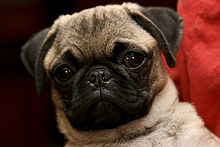- Melanistic mask
-
A melanistic mask (also referred to as a mask or masking) is a dog coat pattern that gives the appearance of a mask on the dog's face. The hairs on the muzzle, and sometimes entire face or ears, are colored by eumelanin instead of pheomelanin pigment. Eumelanin is typically black, but may instead be brown, dark gray, or light gray-brown. Pheomelanin ranges in color from pale cream to mahogany. The trait is caused by M264V (EM), a completely dominant allele (form) of the melanocortin 1 receptor gene.
Contents
Appearance
At minimum, a melanistic mask will appear on the muzzle, and may also be visible on the eartips, entire ears, or entire face. Hairs in those areas will be colored by eumelanin instead of pheomelanin pigment, making it look as though the dog has a mask on its face. Eumelanin is usually black, but may instead be liver (also known as chocolate; dark brown), blue (also known as slate; dark grey), or isabella (also known as lilac; light grey-brown); accordingly, a mask may be any of these colors. Pheomelanin occurs in shades of red ranging from ivory to mahogany, which include cream, gold, and tan.
A mask is visible in conjunction with a variety of coat patterns, such as tan points and sable. Nonetheless, it may be difficult to see with certain others, such as brindle, and will not be visible on a completely eumelanic coat.[1] Any white markings on the coat, caused by a lack of pigment, will appear to be layered over the mask and other markings.
Genetic basis
The melanistic mask is caused by the M264V allele (known as EM) at the melanocortin 1 receptor (MC1R) locus, also known as the extension locus.[1][2] It is completely dominant to the other alleles of the gene, and causes the melanocyte-stimulating hormone to bind to and activate melanocortin 1 receptors (located on melanocytes) in the mask's area, causing those melanocytes to produce eumelanin.[3] Another allele, known as E, is responsible for "normal extension", which allows eumelanin to be produced as usual. e, completely recessive to the other alleles, suppresses all eumelanin production in the coat—the resulting color is sometimes known as recessive red, clear red or Australian red. Therefore, if a dog appears clear red or fawn but has a mask, the agouti gene is responsible for all pheomelanic hairs.[3] Although Clarence Cook Little proposed in 1957 that brindle was caused by another allele at the same locus, known as ebr, his hypothesis was refuted in a 2007 study.[4]
Gallery
-
Longhaired Whippet with black mask
-
Red Dogue de Bordeaux with liver mask
-
Kerry Blue Terrier with black mask. Although the coat on the body has lightened in color in a process known as "clearing" or "greying", the mask has retained its original color.
-
Border Collie puppy with black mask, tan points, and white markings. On the front portion of the muzzle, the points on the cheeks are partially "covered up", or inhibited in expression, by the mask.
References
- ^ a b "Dog Coat Color Tests". Veterinary Genetics Laboratory – UC Davis School of Veterinary Medicine. http://www.vgl.ucdavis.edu/services/coatcolordog.php. Retrieved April 30, 2011.
- ^ Schmutz, S. M.; T. G. Berryere, N. M. Ellinwood, J. A. Kerns, G. S. Barsh (2003). "MCIR Studies in Dogs With Melanistic Mask or Brindle Patterns". Journal of Heredity 94 (1): 69–73. doi:10.1093/jhered/esg01. http://jhered.oxfordjournals.org/content/94/1/69.full. Retrieved April 25, 2011.
- ^ a b Schmutz, Sheila M. "Melanistic Mask". Genetics of Coat Color and Type in Dogs. http://homepage.usask.ca/~schmutz/mask.html. Retrieved April 30, 2011.
- ^ Kerns, J. A.; Cargill, E. J., Clark, L. A., Candille, S. I., Berryere, T. G., Olivier, M., Lust, G., Todhunter, R. J., Schmutz, S. M., Murphy, K. E., Barsh, G. S. (July 2007). "Linkage and Segregation Analysis of Black and Brindle Coat Color in Domestic Dogs". Genetics 176 (3): 1679–1689. doi:10.1534/genetics.107.074237. PMC 1931550. PMID 17483404. http://www.pubmedcentral.nih.gov/articlerender.fcgi?tool=pmcentrez&artid=1931550.
Categories:- Dog anatomy
- Animal hair
- Animal coat colors
Wikimedia Foundation. 2010.







